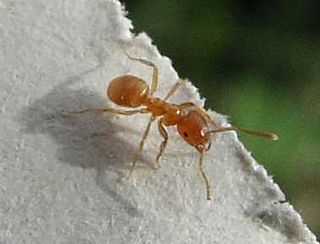| Antennophorus | |
|---|---|
 | |
| Scientific classification | |
| Kingdom: | |
| Phylum: | |
| Class: | |
| Subclass: | |
| Order: | |
| Family: | |
| Genus: | Antennophorus Haller, 1877 |
Antennophorus is a genus of mites in the family Antennophoridae. It was described by Haller in 1877. [1]
| Antennophorus | |
|---|---|
 | |
| Scientific classification | |
| Kingdom: | |
| Phylum: | |
| Class: | |
| Subclass: | |
| Order: | |
| Family: | |
| Genus: | Antennophorus Haller, 1877 |
Antennophorus is a genus of mites in the family Antennophoridae. It was described by Haller in 1877. [1]

Lasius is a genus of formicine ants. The type species for this genus is the black garden ant, Lasius niger. Other major members, which live in drier heathland, are the cornfield ant, L. neoniger, and L. alienus. Other species include the temporary social parasites of the L. mixtus group and the hyper-social parasite Lasius fuliginosus. Lasius flavus is also a commonly seen species, building grassy hillocks in undisturbed pasture. In the Alps, these mounds - always aligned east to catch the first rays of the rising sun - have been traditionally used by goatherds as natural compasses.

The yellow meadow ant,, is one of the most common ants in Central Europe, and it also occurs in Asia and North Africa, but populations in North America are a different, related species.

Xanthogramma pedissequum is a species of hoverfly.

Lasius umbratus, colloquially known as the yellow shadow ant and yellow lawn ant, is a palearctic species of parasitic ant distributed across Eurasia and the Maghreb region of Africa. It was once thought that this species occurred in North America as well, but comparative genomic studies indicate the Afro-Eurasian and American populations are discrete and not closely related enough to represent a single species. The North American populations are now treated as a different species, Lasius aphidicola.
Dendrolaelaps is a genus of mites in the family Digamasellidae.
Dendroseius is a genus of mites in the family Digamasellidae.
Sejidae is a family of mites in the order Mesostigmata.

Uroobovella is a large genus of mites in the family Urodinychidae.

Uropodidae is a family of mites in the order Mesostigmata.

Oplitidae is a family of mites in the order Mesostigmata.
Antennophoridae is a family of mites in the order Mesostigmata.
Euzerconidae is a family of mites in the order Mesostigmata.
L. flavus may refer to:
L. grandis may refer to:

Lasius alienus, or cornfield ant, is a species of ant in the subfamily Formicinae. Workers have a length of about 2–4 mm, Queens are larger (7–9 mm).

Lasius fuliginosus, also known as the jet ant or jet black ant, is a species of ant in the subfamily Formicinae. Workers have a black shiny colour and a length of about 4–6 mm, females are larger (6–6.5 mm) and small males reach a length of 4.5–5 mm). The head is heart-shaped.

Platyarthrus hoffmannseggi is a species of woodlouse which is closely associated with ants' nests, particularly those of Lasius flavus, Lasius niger and species of Myrmica, where it feeds on ant droppings or mildew. It is white, 4 millimetres (0.16 in) long, and has a distinctive oval shape and short antennae. Its distribution appears to follow those of the ants with which it lives, and the British Isles are the north-westerly limit of its range. Elsewhere, P. hoffmannseggii extends south to the Mediterranean Sea. It is found outside Europe in North Africa and Turkey, and has been introduced to Australia and North America.

Claviger is a genus of beetles in the family Staphylinidae, subfamily Pselaphinae. About 40 species and subspecies are described, divided into two subgenera, Claviger (Claviger) and Claviger Clavifer. Claviger displays unusual biological adaptations to myrmecophily. This pselaphid is of palearctic distribution.